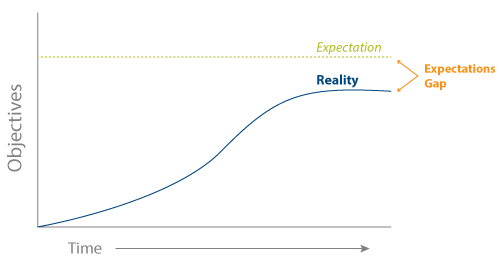The “expectations gap” is a painful experience you’ve encountered at some point in your career – whether you’re a consultant, project manager, sales professional, or anyone who has ever been in a consultative role. You know how it works. The engagement or project starts out a little slow at first. But, then, you hit the point on the growth curve where the project accelerates, and you are creating reports, work products and producing deliverables at a steady pace. Suddenly, and without any prior warning, your client asks, “So, when are you going to get to…?” or “Your team is going to produce… isn’t it?” But, your team never had the intention of “getting to” or “producing” this item your client is now referencing.
What are strategies for avoiding this? Here are five facilitative strategies.
You’re thinking, Surely, you couldn’t have expected us to be able to do all that, given your budget and time constraints. Any reasonable person would see that what you are expecting is simply unreasonable.
Welcome to the expectations gap: that place in time when the realization hits you that what you are creating (or have created) does not match your client’s expectation. It’s a dark, cold and lonely place!
What If…
But, what if the client’s expectation was below the reality line on the graph? What if reality exceeded the client’s expectation line? What a difference, yes? You now are transformed from “egg-on-your-face-sluggo” to “Superman, the hero.” And, note the difference: reality hasn’t changed. You still produce the same deliverable. But, because the client’s expectation is different, the client’s view of you is different!
So, what are strategies for avoiding the expectations gap? How do you stay on the “hero” side of that gap? Here are a few facilitative strategies from our course, The Facilitative Consultant.
1. Define the client’s expectations up front.
- During the “Define the Need” stage, use questioning techniques that focus on understanding the problem, the implications if the problem is not addressed and the benefits of solving the problem.
- Be sure to get your clients definition of success, both short-term and long-term.
2. Establish performance objectives that closely match the client’s expectations.
- We recommend establishing performance objectives in three areas: 1) project objectives related to time frame and budget, 2) business objectives related to how the project impacts business results, and 3) satisfaction objectives to ensure full satisfaction of those impacted.
- Ask the confirmation question: “If we achieve these outcomes and only these outcomes, will the project be a success and meet your expectations?”
- Get sign-off from the client that the performance objectives will meet expectations.
3. Fully define your project scope.
- We recommend three vehicles for fully defining the scope: 1) the deliverables list, 2) the task list and 3) the business area diagram.
- Ask the confirmation question: “If we execute these tasks and only these tasks, work in these areas and only these areas, and produce these deliverables and only these deliverables, will we have focused on all the things important to achieve success?”
- Get sign-off from the client that the scope definition will meet expectations.
4. Hold regular update meetings with a focus on performance against expectations.
- Report against the performance objectives and scope definition to keep the expectations ever present in the mind of the client.
5. Document changes to scope and objectives.
- Implement a formal change control process to ensure that changes in scope or performance outcomes are understood and in agreement.
6. Provide an engagement close letter at project completion.
- The engagement close letter documents performance against scope and performance objectives.
Learn more consulting tips and best practices in our class, The Facilitative Consultant.
About the Author
Michael Wilkinson is the trailblazing Founder of Leadership Strategies, renowned as the foremost provider of professional facilitators and facilitation training in the US. As a Certified Master Facilitator and a Certified Professional Facilitator, Michael’s expertise is in high demand as a trainer, facilitator, and keynote speaker. With a track record of leadership in the facilitation industry, including roles as past president of the Southeast Association of Facilitators, creator of the FindaFacilitator.com database, and founding board member of the International Institute of Facilitation, Michael is a leader in the industry. Dive deeper into his wealth of knowledge through his acclaimed books, including The Executive Guide to Facilitating Strategy, The Secrets of Facilitation, The Secrets to Masterful Meetings, and CLICK: The Virtual Meetings Book.


